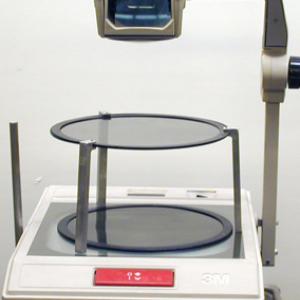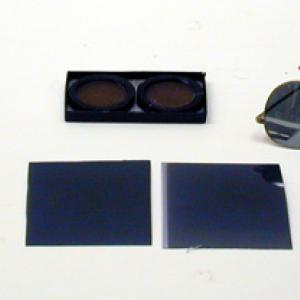College of Liberal Arts & Sciences
6H10.10 - Polarization - Crossed Polaroids
The Polaroid's can be placed at 90 degrees to each other to show total extinction of transmitted light.
- Peizheng Yan, Haojie Xia, Jianquan Li, Yonghong Wang, Yongqing Wei, Feng Ji, Shuangbao Shu, "Polarization Imaging Application with Smartphones", TPT, Vol. 57, #9, Dec. 2019, p. 594-596.
- Dinh Xuan Khoa and Nguyen Huy Bang, "A Low-Cost Experimental Kit for Teaching Wave Optics Based on the CDIO Approach", TPT, Vol. 57, #3, Mar. 2019, p. 168.
- Stefan Richtberg and Raimund Girwidz, "Use of Linear and Circular Polarization: The Secret LCD Screen and 3D Cinema", TPT, Vol. 55, #7, Oct. 2017, p. 406.
- Martín Monteiro, Cecilia Stari, Cecilia Cabeza, and Arturo C. Martí, "The Polarization of Light and Malus' Law Using Smartphones", TPT, Vol. 55, #5, May 2017, p. 264.
- Paul Hewitt, "Figuring Physics", TPT, Vol. 48, #4, Apr. 2010, p. 216.
- Adam S. Green, Paul R. Ohmann, Nick E. Leininger, and James A. Kavanaugh, "Polarization Imaging and Insect Vision", TPT , Vol. 48, #1, Jan 2010, p. 17.
- Giuseppe Colicchia, "A Simple Device for Exploring Optical Activity", TPT, Vol. 42, #8, Nov. 2004, p. 478.
- Kelly Krieble and Joseph L. Powlette, "A Simple Apparatus for Optical Polarization Experiments", TPT, Vol. 41, #9, Dec. 2003, p. 537.
- Don Easton, "Transmission Through Crossed Polaroid Filters", TPT, Vol. 39, #4, Apr. 2001, p. 231.
- Richard E. Stevens, "A Simulation of Optical Polarization", TPT, Vol. 38, #4, Apr. 2000, p. 222.
- Jukka O. Mattila, "Laptop Art", TPT, Vol. 34, #2, Feb. 1996, p. 78.
- H. Richard Crane, "The Quarts Watch With Digital Readout", TPT, Vol. 32, #5, May 1994, p. 298.
- Bill Reid, "Colored Flag by Double Refraction", TPT, Vol. 32, #1, Jan. 1994, p. 38.
- Paul Changnon, "Animated Displays IV: Linear Polarization", TPT, Vol. 31, #8, Nov. 1993, p. 489.
- John Harris and Vittorio Zanetti, "Sunglasses That Switch On and Off", TPT, Vol. 28, #4, Apr. 1990, p. 200.
- Ruth Goehmann and Scott Welty, "Polarized Light: Three Demonstrations", TPT, Vol. 22, #5, May 1984, p. 307.
- M. Ameloot and H. Hendrickx, "Determination of the Polarizing Direction of Polarizers", TPT, Vol. 21, #9, Dec. 1983, p. 590.
- Bruce H. Morgan, "Polarization Effects With Pendulums", TPT, Vol. 20, #8, Nov. 1982, p. 541.
- Herbert H. Gottlleb, "The Law of Malus Using Polaroid Polarizers", TPT, Vol. 18, #8, Nov 1980, p. 612.
- A. F. Leung, "The Law of Malus Using Polaroid Polarizers", TPT, Vol. 18, #8, Nov. 1980, p. 612.
- Robert P. Bauman and Dennis R. Moore, "Classical Demonstration of Polarization", TPT, Vol. 18, #3, Mar. 1980, p. 214, also A Potpourri of Physics Teaching Ideas - Optics and Waves, p. 234.
- E. F. Carr and J. P. McClymer, "A Laboratory Experiment on Interference of Polarized Light Using a Liquid", AJP, Vol. 59, #4, Apr. 1991, p. 366.
- Terry S. Carlton, "Quantum Mechanical Demonstrations with Polarized Light", AJP, Vol. 42, #5, May 1974, p. 408.
- Sydney B. Lang, "Pyroelectricity: From Ancient Curiosity to Modern Imaging Tool", Physics Today, Vol. 58, #8, Aug. 2005, p. 31.
- Om-8, 9: Freier and Anderson, A Demonstration Handbook for Physics.
- O-605: "Coil Spring and Two Big Slits", DICK and RAE Physics Demo Notebook.
- O-610: "Polaroid (TM) - Malus' Law", DICK and RAE Physics Demo Notebook.
- Jearl Walker, "More about Polarizers and How to Use Them, Particularly for Studying Polarized Sky Light", The Amateur Scientist, January, 1978.
- "Suggestions for the Use of Polaroid in Demonstrations of Polarized Light", The Polarizing Instrument Company.
- Bill Franklin, "Observing the Polarization of Light", Teaching about Color & Color Vision, 1996, p. 3D-1.
- Bill Franklin, "Understanding Polarization Colors", Teaching about Color & Color Vision, 1996, p. 2D-1.
- Borislaw Bilash II and David Maiullo, "Can You See Me Now?", A Demo a Day: A Year of Physics Demonstrations, p. 322.
- H. Richard Crane, "Stretch Orientation: A Process of a Hundred Uses", How Thing Work (1983 - 1995), p. 28.
- "The Visible World - How Light Waves Travel", The Boy Scientist, p. 180.
- Jearl Walker, "7.38. Honeybees, Desert Ants, and Polarized Light", The Flying Circus of Physics Ed. 2, p. 319.
- Jearl Walker, "6.128. Ant Navigation", The Flying Circus of Physics Ed. 2, p. 296.
- Jearl Walker, "6.126. Polarizing Sunglasses", The Flying Circus of Physics Ed. 2, p. 294.
- Yaakov Kraftmakher, "1.19 Malus' Law", Experiments and Demonstrations in Physics, ISBN 981-256-602-3, p. 72.
- Hollis N. Todd, Polarization of Light: Basic Theory and Experiments, Cambridge Instrument Inc., 1970.
- John H. Moore, Christopher C. Davis, and Michael A. Coplan, "Polarizers", Building Scientific Apparatus 2nd Edition, p. 157 - 164.
- Robert Ehrlich, "Crossed Polaroid's and Optical Activity", Turning the World Inside Out, p. 172 - 173.
- Ron Hipschman, "Polaroid Island", Exploratorium Cookbook III, p. 173.1 - 173.3.
- Ron Hipschman, "Glass Catfish", Exploratorium Cookbook II, p. 97.1 - 97.2.
- "2, Experiment with Polarizing Filter", Experiments in Optics, Part 2, Klinger Scientific Apparatus Corp., Bulletin 101- 2.
- T. D. Rossing and C. J. Chiaverina, "7.1, Polarization By Selective Absorption", Light Science, Physics and Visual Arts, p. 152.
- T. D. Rossing and C. J. Chiaverina, "7.8, Optical Activity", Light Science, Physics and Visual Arts, p. 163.
- W. Bolton, "6. The Effect of Polarized Light on Insects", Book 2 - Waves and Particles, Physics Experiments and Projects, 1968, p. 80.
- W. Bolton, "Polarization of Light", Book 2 - Waves and Particles, Physics Experiments and Projects, 1968, p. 25.
- V. E. Eaton, C. J. Overback, R. J. Stephenson, and Marsh W. White, "Polarized Light, Selective Experiments in Physics", 1943.
- Joseph Frick, "#194 & 195 - Undulation of Polarized Light & Polarizing Apparatus", Physical Technics: Or Practical Instructions for Making Experiments in Physics and the Construction of Physical Apparatus with the Most Limmited Means, p. 225.
Disclaimer: These demonstrations are provided only for illustrative use by persons affiliated with The University of Iowa and only under the direction of a trained instructor or physicist. The University of Iowa is not responsible for demonstrations performed by those using their own equipment or who choose to use this reference material for their own purpose. The demonstrations included here are within the public domain and can be found in materials contained in libraries, bookstores, and through electronic sources. Performing all or any portion of any of these demonstrations, with or without revisions not depicted here entails inherent risks. These risks include, without limitation, bodily injury (and possibly death), including risks to health that may be temporary or permanent and that may exacerbate a pre-existing medical condition; and property loss or damage. Anyone performing any part of these demonstrations, even with revisions, knowingly and voluntarily assumes all risks associated with them.

